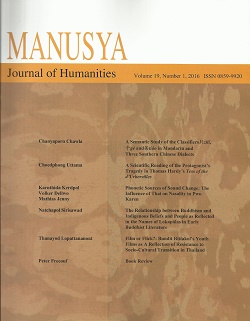Title : A Semantic Study of the Classifier 只zhī, 个gè And 条tiáo in Mandarin And Three Southern Chinese Dialects
Author(s) : Chanyaporn Chawla
Pages : 1-27
Abstract in English : As we know, in spoken language, 个gè is a
commonly accepted general classifier 3 in
Modern Chinese. However, this is not the
case for other dialects. In the Southern
dialects, the specific classifier 只zhī in
Mandarin is adopted (Wang, 2008 (c): 279-
281). Additionally, in certain Southern
dialects, 条tiáo has a wide range of uses.
Thus, it can be said that all these individual
classifiers share one common feature: all
are often used with several kinds of common
nouns, i.e. for persons, animals, body parts,
objects of daily use, etc. Consequently, in
this paper, I will explore the three Chinese
classifiers 只zhī, 个gè and 条tiáo in
Mandarin, comparing them with the three
other Southern dialects, namely Hakka,
Chaozhou, and Cantonese, employing the
prototype theory (Rosch, 1978) and
interview technique, in order to reveal how
Northern and Southern people view the
world through these classifiers.


